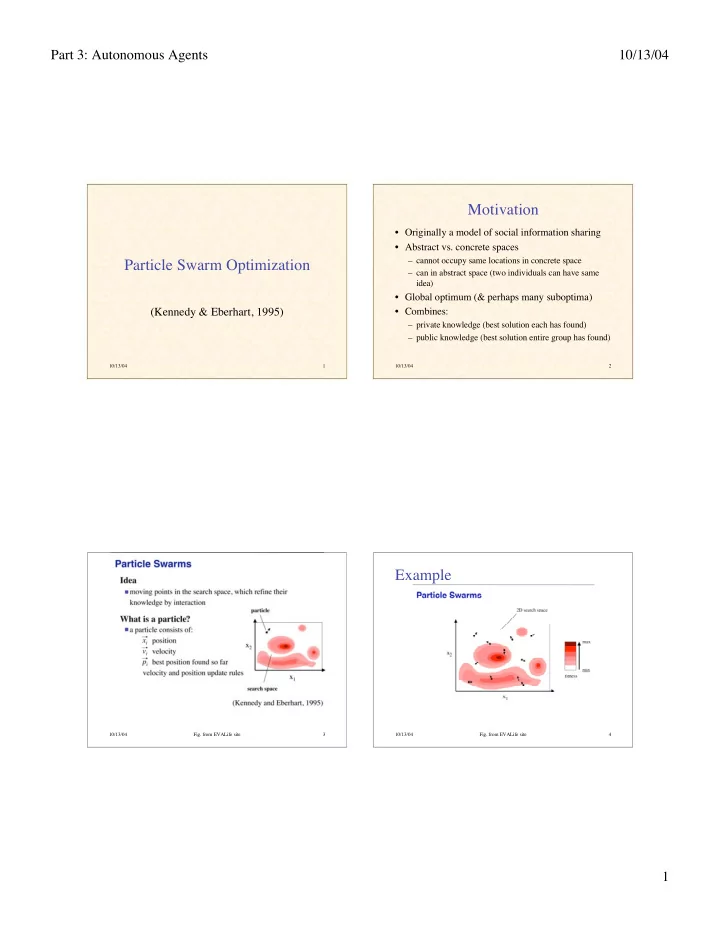

Part 3: Autonomous Agents 10/13/04 Motivation • Originally a model of social information sharing • Abstract vs. concrete spaces – cannot occupy same locations in concrete space Particle Swarm Optimization – can in abstract space (two individuals can have same idea) • Global optimum (& perhaps many suboptima) (Kennedy & Eberhart, 1995) • Combines: – private knowledge (best solution each has found) – public knowledge (best solution entire group has found) 10/13/04 1 10/13/04 2 Example 10/13/04 Fig. from EVALife site 3 10/13/04 Fig. from EVALife site 4 1
Part 3: Autonomous Agents 10/13/04 Example Example 10/13/04 Fig. from EVALife site 5 10/13/04 Fig. from EVALife site 6 Example Example 10/13/04 Fig. from EVALife site 7 10/13/04 Fig. from EVALife site 8 2
Part 3: Autonomous Agents 10/13/04 Example Example 10/13/04 Fig. from EVALife site 9 10/13/04 Fig. from EVALife site 10 Example Variables x k = current position of particle k v k = current velocity of particle k p k = best position found by particle k Q ( x ) = quality of position x g = index of best position found so far i.e., g = argmax k Q ( p k ) � 1 , � 2 = random variables uniformly distributed over [0, 2] w = inertia < 1 10/13/04 Fig. from EVALife site 11 10/13/04 12 3
Part 3: Autonomous Agents 10/13/04 Velocity & Position Updating Improvements v k � = w v k + � 1 ( p k – x k ) + � 2 ( p g – x k ) • Alternative velocity update equation: w v k maintains direction ( inertial part) v k � = � [ w v k + � 1 ( p k – x k ) + � 2 ( p g – x k )] � 1 ( p k – x k ) turns toward private best ( cognition part) � = constriction coefficient (controls magnitude of v k ) � 2 ( p g – x k ) turns towards public best ( social part) • Alternative neighbor relations: x k � = x k + v k – star : fully connected (each responds to best of all others; fast information flow) • Allowing � 1 , � 2 > 1 permits overshooting and better – circle : connected to K immediate neighbors (slows exploration ( important! ) information flow) • Good balance of exploration & exploitation – wheel : connected to one axis particle (moderate information flow) • Limiting || v k || < || v max || controls resolution of search 10/13/04 13 10/13/04 14 Spatial Extension Some Applications of PSO • integer programming • minimax problems – in optimal control – engineering design – discrete optimization – Chebyshev approximation – game theory • multiobjective optimization • Spatial extension avoids premature convergence • hydrologic problems • Preserves diversity in population • musical improvisation! • More like flocking/schooling models 10/13/04 Fig. from EVALife site 15 10/13/04 16 4
Part 3: Autonomous Agents 10/13/04 Millonas’ Five Basic Principles Kennedy & Eberhart on PSO of Swarm Intelligence “This algorithm belongs ideologically to that 1. Proximity principle: philosophical school pop. should perform simple space & time computations that allows wisdom to emerge rather than trying to 2. Quality principle: impose it, pop. should respond to quality factors in environment that emulates nature rather than trying to control it, 3. Principle of diverse response: and that seeks to make things simpler rather than more pop. should not commit to overly narrow channels complex. 4. Principle of stability: Once again nature has provided us with a technique pop. should not change behavior every time env. changes for processing information that is at once elegant 5. Principle of adaptability: and versatile.” pop. should change behavior when it’s worth comp. price 10/13/04 (Millonas 1994) 17 10/13/04 18 Additional Bibliography 1. Camazine, S., Deneubourg, J.-L., Franks, N. R., Sneyd, J., Theraulaz, G.,& Bonabeau, E. Self-Organization in Biological Systems . Princeton, 2001, chs. 11, 13, 18, 19. 2. Bonabeau, E., Dorigo, M., & Theraulaz, G. Swarm Intelligence: From Natural to Artificial Systems . Oxford, 1999, chs. 2, 6. 3. Solé, R., & Goodwin, B. Signs of Life: How Complexity Pervades Biology . Basic Books, 2000, ch. 6. 4. Resnick, M. Turtles, Termites, and Traffic Jams: Explorations in Massively Parallel Microworlds . MIT Press, 1994, pp. 59-68, 75- 81. 5. Kennedy, J., & Eberhart, R. “Particle Swarm Optimization,” Proc. IEEE Int’l. Conf. Neural Networks (Perth, Australia), 1995. http://www.engr.iupui.edu/~shi/pso.html . IV 10/13/04 19 5
Recommend
More recommend